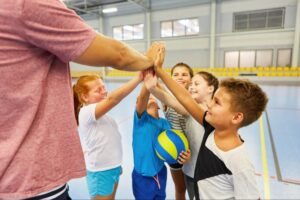
In today’s fast-paced world, fostering a healthy lifestyle for elementary students is more important than ever. With the increasing prevalence of sedentary behavior and unhealthy eating habits, schools and parents must prioritize health and wellness activities that engage children physically, mentally, and socially. These different activities play a vital role in promoting overall well-being. This blog will explore various mental health and wellness activities that children can participate in to promote overall well-being, making learning about health fun and interactive.
The Importance of Mental Health for Elementary Students
Mental health is crucial to a child’s overall development, yet it often receives less attention than physical health. Mental well-being significantly impacts children’s ability to learn, socialize, and manage daily challenges. According to the Centers for Disease Control and Prevention (CDC), 1 in 5 children ages 3-17 has a mental, emotional, or behavioral disorder. Fostering a supportive environment that promotes mental wellness is essential for helping children develop resilience, emotional intelligence, and coping skills.
Addressing mental health in elementary schools and at home can create a safe space for students to express their feelings and learn how to manage stress and anxiety. Activities that promote mental health enhance academic performance and encourage positive social interactions, making students more well-rounded.
The Benefits of Health and Wellness Activities for Young Learners
Before diving into specific activities, it’s essential to understand why health and wellness activities are crucial for elementary students. Engaging in regular physical activity can help children:
- Enhance Physical Health: Regular exercise supports cardiovascular health, muscle strength, flexibility, and overall fitness. It also helps reduce the risk of childhood obesity and related health issues.
- Boost Mental Health: Physical activity has been linked to improved mood, reduced anxiety, and enhanced cognitive function. Engaging in wellness activities can also promote better concentration and academic performance.
- Develop Social Skills: Many health and wellness activities are group-oriented, providing opportunities for children to develop teamwork, communication, and leadership skills while building friendships.
- Encourage Healthy Habits: Introducing children to fun, healthy activities can instill lifelong wellness habits, encouraging them to continue making healthy choices as they grow.
Fun Physical Activities
A. Outdoor Games
- Capture the Flag
Capture the Flag is a classic outdoor game that promotes exercise, teamwork, and strategic thinking while enjoying the fresh air. Divide students into two teams, assign each team a color, and place flags in their territory. The objective is to capture the opposing team’s flag while protecting your own. This game promotes cardiovascular fitness as children run, dodge, and strategize. - Obstacle Course Challenge
Creating an obstacle course can be a fun and engaging way to improve children’s coordination, agility, and strength. Use cones, hula hoops, jump ropes, and other equipment to set up challenges. Students can take turns racing through the course, competing for the best time or encouraging each other to improve their performance
B. Sports and Team Activities
- Soccer
Soccer is a fantastic way for students to engage in cardiovascular exercise while learning the importance of teamwork and sportsmanship. Organizing soccer games during recess or physical education classes can help develop skills such as passing, shooting, and defending. - Basketball
Basketball is another excellent team sport that promotes fitness and hand-eye coordination. Setting up a mini-basketball tournament can encourage students to work together and build their skills while having fun.
C. Dance and Movement
- Dance Parties
Organizing dance parties can be a fantastic way to get children moving and expressing themselves creatively. Play upbeat music and encourage students to dance freely or follow along with structured dance routines. Dance parties can also serve as a great break between academic activities. - Zumba
Zumba classes combine music and movement to create a fun workout environment. These classes are designed specifically for children, incorporating age-appropriate choreography that encourages cardiovascular fitness and rhythm. Schools can invite a certified Zumba instructor to lead sessions or use online resources for guided classes.
Mindfulness and Mental Health Activities
A. Yoga and Stretching
- Kids Yoga
Yoga is an excellent way to promote relaxation, flexibility, and mindfulness in children. Many online resources offer kid-friendly yoga sessions incorporating fun stories, animal poses, and games. Practicing yoga can help students learn to manage stress, improve focus, and develop body awareness. - Guided Stretching Sessions
Simple stretching sessions can be incorporated into the school day to promote relaxation and physical well-being. A teacher can lead a short stretching routine, encouraging students to stretch different muscle groups and focus on their breathing.
B. Mindfulness Practices
- Mindfulness Minute
Incorporating a “Mindfulness Minute” into the school day allows students to practice being present and aware. During this time, students can focus on their breathing, listen to calming sounds, or engage in guided imagery exercises. This practice can help reduce stress and improve focus throughout the day. - Gratitude Journaling
Encouraging students to keep gratitude journals can foster a positive mindset and emotional well-being. Allocate time for students to reflect on what they are thankful for daily. This practice helps children recognize the positive aspects of their lives and promotes a sense of community when shared with classmates.
Nutrition and Healthy Eating Activities
A. Healthy Cooking Classes
- Cooking Workshops
Organizing cooking workshops can teach students about nutrition and the importance of maintaining a healthy diet while providing hands-on experiences in the kitchen. Choose simple, healthy recipes that students can prepare together, such as smoothies, fruit salads, or veggie wraps. These workshops can instill healthy cooking skills and foster an appreciation for nutritious foods.
B. Gardening Programs
- School Garden
Creating a school garden can provide students with practical knowledge about where their food comes from and the importance of healthy eating. Students can participate in planting, maintaining, and harvesting fruits and vegetables, promoting physical activity and environmental awareness. Incorporating gardening lessons into science classes can enhance students’ understanding of nutrition.
Community Engagement Activities
A. Health and Wellness Fairs
- Organizing a Health Fair
Schools can organize health and wellness fairs to encourage families to participate in healthy activities. Invite local health professionals, fitness instructors, and nutritionists to provide workshops, demonstrations, and information booths. Engage students in planning and promoting the event to develop leadership skills and foster community involvement.
B. Fundraising Runs/Walks
- Charity Walks or Runs
Organizing charity runs or walks can promote physical activity while raising funds for a good cause. Students can participate as individuals or in teams, setting goals for distance or time. This activity encourages community engagement and fosters a sense of purpose in students.
Integrating Health and Wellness into the Curriculum
A. Incorporating Wellness Education
- Health Education Classes
Schools can incorporate health education classes into their curriculum to teach students about nutrition, exercise, mental health, and wellness practices. This foundational knowledge will empower students to make informed choices about their health and well-being.
B. Cross-Curricular Activities
- Thematic Units
Integrating health and wellness themes into other subjects can enhance learning experiences. For example, in a science class, students can learn about the human body and nutrition, while in art class, they can create posters promoting healthy habits. This interdisciplinary approach can make health education more engaging and relevant.
Encouraging Family Involvement
A. Family Health Challenges
- Family Fitness Challenges
Encouraging family members to participate in fitness challenges can promote healthy habits at home. Schools can provide resources for families to track their movement, healthy meals, and wellness goals. Families can compete or collaborate to achieve their objectives, fostering a sense of community and accountability.
B. Healthy Family Nights
- Family Fun Nights
Hosting family fun nights focused on health and wellness can create opportunities for family members to bond and engage in healthy activities together. Activities can include cooking classes, yoga sessions, or family game nights featuring active games.
Technology and Health
A. Educational Apps
- Health and Wellness Apps
Incorporating technology into health education can make learning about wellness more engaging. Numerous apps designed for children teach healthy habits, nutrition, and fitness through games and interactive lessons. Schools can encourage students to explore these resources, fostering a sense of responsibility for their mental health.
B. Virtual Fitness Classes
- Online Workouts
As technology evolves, schools can take advantage of online fitness classes and videos. These resources can be utilized for at-home workouts, ensuring students remain active outside school hours. Encourage families to participate together, making fitness a fun, shared experience.
Conclusion
Promoting health and wellness activities for elementary students is vital in fostering lifelong healthy habits. By incorporating various engaging physical, mental health, and nutritional activities into the school environment, educators and parents can encourage kids to prioritize their well-being. From outdoor games and team sports to mindfulness practices and nutrition education, there are countless ways to make health a fun and integral part of students’ lives. Together, we can empower our children to embrace a healthy lifestyle that benefits their physical wellness, mental health, emotional wellness, and overall happiness.
By fostering an environment that encourages exploration, creativity, and health-related learning, we prepare our children to thrive not just in their academic pursuits but in life. Let’s work together to cultivate a generation of healthy, happy, and informed individuals who will carry these important lessons forward.









